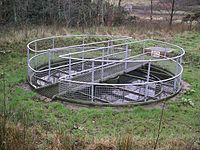
Photo from wikipedia
Abstract The aim of the present study was to compare the oxygen transfer efficiency in a conventional activated sludge and a membrane bioreactor system. The oxygen transfer was evaluated by… Click to show full abstract
Abstract The aim of the present study was to compare the oxygen transfer efficiency in a conventional activated sludge and a membrane bioreactor system. The oxygen transfer was evaluated by means of the oxygen transfer coefficient and α-factor calculation, under different total suspended solids concentration, extracellular polymeric substances, sludge apparent viscosity and size of the flocs. The oxygen transfer coefficient and α-factor showed an exponential decreasing trend with total suspended solid, with a stronger oxygen transfer coefficient dependence in the conventional activated sludge compared to the membrane bioreactor. It was noted that the oxygen transfer coefficient in the conventional activated sludge become comparable to that in membrane bioreactor when the total suspended solid concentration in the conventional activated sludge was higher than 5 g L−1. Operating under high carbon to nitrogen ratio, the oxygen transfer coefficient increased in both conventional activated sludge and membrane bioreactor because of sludge deflocculation and it was noticed a weaker dependence of the oxygen transfer coefficient with total suspended solid. The results indicated that the most important parameters on the oxygen transfer efficiency were in order: the total suspended solid concentration, flocs size, sludge apparent viscosity and extracellular polymeric substances content. Based on the influence of the main biomass features affecting the oxygen transfer coefficient and considering the typical operating conditions in both systems, those of membrane bioreactor appeared to be more favorable to oxygen transfer efficiency. The paper provides a useful insight about some peculiarities of oxygen transfer in a conventional activated sludge and a membrane reactor system, highlighting new and useful information in the light of a more sustainable management of these systems.
Journal Title: Journal of Cleaner Production
Year Published: 2019
Link to full text (if available)
Share on Social Media: Sign Up to like & get
recommendations!